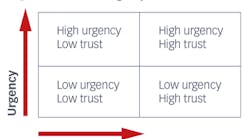Retaining new patients for life: The Treatment Decision Matrix
Editor's note: This article is part two of a three-part series. Part one appeared in October. Part three will appear in December.
I recently attended a conference of the American Academy of Oral Systemic Health. While there, I spoke to a successful dentist from the Washington, DC, area. She shared her story about how she had purchased an older practice and, with the help of a top scheduling company, grew it to 1,500 patients and $1,500,000 in revenue. She also shared that she wanted to continue to grow the practice. As we talked, we discovered a huge opportunity.
Her practice, she said, added 50 to 100 patients per month-usually closer to 100. This amounted to approximately 900 new patients per year. However, her overall patient count was stagnant at 1,500. This meant that only 600 patients were being reappointed each year.
Sending new patients through the top of the practice funnel without an effective patient retention system is like being on a treadmill with no stop button. Yes, you will lose weight, but you won't have the freedom to enjoy it.
For my clients, the first step in changing a situation like this is to implement the Treatment Decision Matrix (TDM). The TDM is a three-part system that allows you and your team to connect with new patients and convert them at the crucial decision point-their first visit. It also allows you to get your patients healthier and grow your practice exponentially, because you retain patients for a lifetime.
The three components of the TDM are personality processing, trust and urgency, and point of reference. Last month, we discussed personality processing. To review, personality processing enables you to establish trust and connect on a deep level with patients. By using the right approach to communicate with them-one that matches the approach they use to make decisions-they feel heard, they feel understood, and you keep them in their comfort zones.
In this article, we will look at trust and urgency. I like to explain this concept using the "Trust and Urgency Table" (figure 1). Its purpose is to teach practitioners and their teams the amount of treatment to present.i Determining the sweet spot on the first visit will make or break whether the patient stays and then refers others.
When we first start training teams, we find two extremes when it comes to how much treatment is presented. At one extreme, the doctor recommends full comprehensive care for most patients. At the other extreme, the doctor recommends an insurance-inspired "one-tooth-treatment-a-year" approach. This is the type of doctor who sees many emergencies because he or she runs a "watch and patch" facility. Few patients turn into long-term customers.
The good news is that there's no single right way to treatment plan. The most important thing is that you meet customers where they're starting and then take them where they need to go. People buy what they want, not what they need, so you need to start with giving them what they want.
Let's now look at how the Trust and Urgency Table works. Think of a patient as being somewhere along the x-axis and y-axis. The x-axis has low trust on the left and high trust on the right. The y-axis has low urgency at the bottom and high urgency at the top.
First, let's look at trust. If a patient comes in from Groupon or just happens to be passing by your practice and walk in, this is considered a low-trust patient. They're probably coming in because they are price shopping or because your location is convenient. By contrast, consider the patient who comes in as a referral from one of your best patients. This patient comes to you because their friend talks incessantly about how great you are and how you changed their life. This would be considered a high-trust patient.
Now let's look at urgency. High on the urgency axis is someone who comes in saying that they're getting married in six months and they want to look good and feel good for pictures. By contrast, someone who comes in and says they "just want a cleaning" has low urgency.
Let's now look at how trust and urgency relate. If a new patient comes in with pain and they found you on the Internet, they have high urgency and low trust. This places them in quadrant one. Your goal should be to focus on what they want-to get out of pain-and then convince them about what they need, which is avoiding a similar cost and more pain in the future. They need regular preventive care.
When you have a patient with high trust, like the sister of a great patient for whom you've done comprehensive work, and they have low urgency, this places them in quadrant two. For these patients, find out their personal motivator and their benchmark of healthy. (These concepts are discussed in my previous article.) You can then visually see the gap between where they are and where they could be as it relates to what is important to them. You create urgency to address the condition.
When you have a patient in quadrant three, which is low trust, high urgency, it is vital to understand how they process information. They want the bottom line, they have questions, and they need to know the step-by-step process. They want to know how little this will intrude on their time and money. (Again, see part one of this series for further explanation.)
Quadrant four is where comprehensive cases are presented and closed. Fourth quadrant cases are not always born that way. It takes art, science, and a team approach to get patients to this point.
Once you master this strategy you will increase both case acceptance and patient retention, thereby allowing you to give your team bonuses and have the practice perform well financially while making a profound difference in the lives of many.
Next month, we will look at point of reference. This will allow you to see where patients are starting from and help you to take them to where they want to go.
Note
i. This is often a blind spot for offices. What we find is that most offices present the same way based upon their philosophy and their doctors' "personal deserve level." For more information on this, check out Raise your Healthy Deserve Level (nextlevelpractice.com/products). This is ideal for practitioners who have a tendency to self-sabotage their success.
Gary Kadi is CEO of NextLevel Practice. He created NextLevel Practice to implement the Complete Health Dentistry business model, where teams willingly embrace and implement change, patients respect their treatment regimens and invest in their health, and doctors enjoy practicing the way they envisioned when they graduated from dental school.








